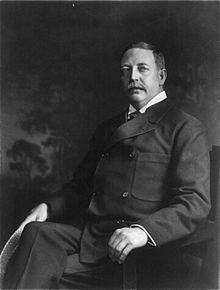Curtis Guild Jr. | |
|---|---|
 c. 1905 portrait photograph by John Garo | |
| United States Ambassador to Russia | |
| In office August 17, 1911 – April 24, 1913 | |
| President | William Howard Taft Woodrow Wilson |
| Preceded by | William Woodville Rockhill |
| Succeeded by | George T. Marye |
| 43rd Governor of Massachusetts | |
| In office January 4, 1906 – January 7, 1909 | |
| Lieutenant | Eben Sumner Draper |
| Preceded by | William L. Douglas |
| Succeeded by | Eben Sumner Draper |
| 39th Lieutenant Governor of Massachusetts | |
| In office January 8, 1903 – January 4, 1906 | |
| Governor | John L. Bates William L. Douglas |
| Preceded by | John L. Bates |
| Succeeded by | Eben Sumner Draper |
| Member of the Massachusetts House of Representatives | |
| In office 1881 | |
| Personal details | |
| Born | February 2, 1860 Boston, Massachusetts, U.S. |
| Died | April 6, 1915 (aged 55) Boston, Massachusetts, U.S. |
| Political party | Republican |
| Profession | Politician |
| Signature | |
Curtis Guild Jr. (February 2, 1860 – April 6, 1915) was an American journalist, soldier, diplomat and politician from Massachusetts. He was the 43rd governor of Massachusetts, serving from 1906 to 1909. Prior to his election as governor, Guild served in the Massachusetts Volunteer Militia, seeing active duty in Cuba during the Spanish–American War. He was publisher of the Boston Commercial Bulletin, a trade publication started by his father.
Educated at Harvard, where he became a close friend of Theodore Roosevelt, Guild was like Roosevelt, a progressive Republican, active in the party organization from 1881. During his tenure as governor, a number of social, labor, and government reforms were enacted. After leaving that office, he was considered a potential candidate for Vice President of the United States in 1908, and served for two years as United States Ambassador to Russia.